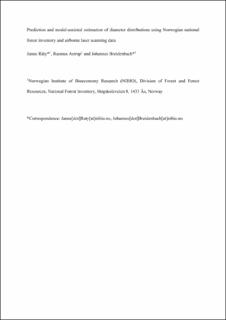| dc.contributor.author | Räty, Janne | |
| dc.contributor.author | Astrup, Rasmus Andreas | |
| dc.contributor.author | Breidenbach, Johannes | |
| dc.date.accessioned | 2021-11-04T09:14:40Z | |
| dc.date.available | 2021-11-04T09:14:40Z | |
| dc.date.created | 2021-10-18T09:58:46Z | |
| dc.date.issued | 2021-04-07 | |
| dc.identifier.citation | Canadian Journal of Forest Research. 2021, 51 (10), 1521-1533. | en_US |
| dc.identifier.issn | 0045-5067 | |
| dc.identifier.uri | https://hdl.handle.net/11250/2827785 | |
| dc.description.abstract | Diameter at breast height (DBH) distributions offer valuable information for operational and strategic forest management decisions. We predicted DBH distributions using Norwegian national forest inventory and airborne laser scanning data and compared the predictive performances of linear mixed-effects (PPM), generalized linear-mixed (GLM), and k nearest-neighbor (NN) models. While GLM resulted in smaller prediction errors than PPM, both were clearly outperformed by NN. We therefore studied the ability of the NN model to improve the precision of stem frequency estimates by DBH classes in the 8.7 Mha study area using a model-assisted (MA) estimator suitable for systematic sampling. MA estimates yielded greater than or approximately equal efficiencies as direct estimates using field data only. The relative efficiencies (REs) associated with the MA estimates ranged between 0.95–1.47 and 0.96–1.67 for 2 and 6 cm DBH class widths, respectively, when dominant tree species were assumed to be known. The use of a predicted tree species map, instead of the observed information, decreased the REs by up to 10%. | en_US |
| dc.language.iso | eng | en_US |
| dc.publisher | Canadian Science Publishing | en_US |
| dc.title | Prediction and model-assisted estimation of diameter distributions using Norwegian national forest inventory and airborne laser scanning data | en_US |
| dc.type | Peer reviewed | en_US |
| dc.type | Journal article | en_US |
| dc.description.version | acceptedVersion | en_US |
| dc.rights.holder | © 2021 The Author(s) | en_US |
| dc.source.pagenumber | 1521-1533 | en_US |
| dc.source.volume | 51 | en_US |
| dc.source.journal | Canadian Journal of Forest Research | en_US |
| dc.source.issue | 10 | en_US |
| dc.identifier.doi | 10.1139/cjfr-2020-0440 | |
| dc.identifier.cristin | 1946586 | |
| dc.relation.project | Norges forskningsråd: 11067 | en_US |
| cristin.ispublished | true | |
| cristin.fulltext | postprint | |
| cristin.qualitycode | 1 | |
